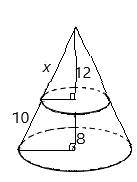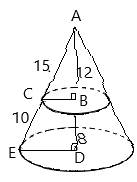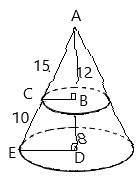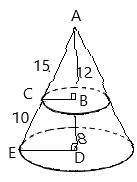
a.
To calculate: The value of x .
a.
Answer to Problem 14PSB
The value of x is
Explanation of Solution
Given information:
Height of small cone = 12,
Slant height of small cone = x ,
Height of large cone
Slant height of large cone
Formula used:
The below property is used:
Corresponding sides of similar
Calculation:

The smaller triangle is similar to the whole triangle by AA similarity rule, so
Corresponding sides of similar triangles are congruent.
b.
To find: The radii of the
b.
Answer to Problem 14PSB
The radii are 9 and 15.
Explanation of Solution
Given information:
Height of small cone = 12,
Slant height of small cone = x ,
Height of large cone
Slant height of large cone
Formula used:
The below property is used:
Corresponding sides of similar triangles are congruent.
The below theorem is used:
Pythagoras theorem states that “In a right angled triangle, the square of the hypotenuse side is equal to the sum of squares of the other two sides”.

In right
Calculation:

The smaller triangle is similar to the whole triangle by AA similarity rule, so
Corresponding sides of similar triangles are congruent.
Radius of small circle:
Side BC can be calculated by applying Pythagoras Theorem.
In right angled triangle ABC , we get
Radius of large circle:
Side ED can be calculated by applying Pythagoras Theorem.
In right angled triangle ADE , we get
c.
To calculate: The volume of smaller cone.
c.
Answer to Problem 14PSB
The volume of smaller cone is
Explanation of Solution
Given information:
Height of small cone = 12,
Slant height of small cone = x ,
Height of large cone
Slant height of large cone
Formula used:
The below property is used:
Corresponding sides of similar triangles are congruent.
The below theorem is used:
Pythagoras theorem states that “In a right angled triangle, the square of the hypotenuse side is equal to the sum of squares of the other two sides”.

In right angle triangle,
Volume of cone
B = Base area of cone and h = height of cone
Area of a circle:
r = radius of circle
Calculation:

The smaller triangle is similar to the whole triangle by AA similarity rule, so
Corresponding sides of similar triangles are congruent.
Radius of small circle:
Side BC can be calculated by applying Pythagoras Theorem.
In right angled triangle ABC , we get
Volume of cone
Volume of smaller cone
Volume of smaller cone
Volume of smaller cone
d.
To calculate: The volume of larger cone.
d.
Answer to Problem 14PSB
The volume of larger cone is
Explanation of Solution
Given information:
Height of small cone = 12,
Slant height of small cone = x ,
Height of large cone
Slant height of large cone
Formula used:
The below property is used:
Corresponding sides of similar triangles are congruent.
The below theorem is used:
Pythagoras theorem states that “In a right angled triangle, the square of the hypotenuse side is equal to the sum of squares of the other two sides”.

In right angle triangle,
Volume of cone
B = Base area of cone and h = height of cone
Area of a circle:
r = radius of circle
Calculation:

The smaller triangle is similar to the whole triangle by AA similarity rule, so
Corresponding sides of similar triangles are congruent.
Radius of large circle:
Side ED can be calculated by applying Pythagoras Theorem.
In right angled triangle ADE , we get
Volume of cone
Volume of larger cone
Volume of larger cone
Volume of larger cone
e.
To calculate: The volume of the frustum.
e.
Answer to Problem 14PSB
The volume of the frustum is
Explanation of Solution
Given information:
Height of small cone = 12,
Slant height of small cone = x ,
Height of large cone
Slant height of large cone
Formula used:
The below property is used:
Corresponding sides of similar triangles are congruent.
The below theorem is used:
Pythagoras theorem states that “In a right angled triangle, the square of the hypotenuse side is equal to the sum of squares of the other two sides”.

In right angle triangle,
Volume of cone
B = Base area of cone and h = height of cone
Area of a circle:
r = radius of circle
Calculation:

The smaller triangle is similar to the whole triangle by AA similarity rule, so
Corresponding sides of similar triangles are congruent.
Radius of small circle:
Side BC can be calculated by applying Pythagoras Theorem.
In right angled triangle ABC , we get
Volume of cone
Volume of smaller cone
Volume of smaller cone
Volume of smaller cone
Radius of large circle:
Side ED can be calculated by applying Pythagoras Theorem.
In right angled triangle ADE , we get
Volume of cone
Volume of larger cone
Volume of larger cone
Volume of larger cone
Volume of frustum = Volume of larger cone − Volume of smaller cone
Volume of frustum
Volume of frustum
Volume of frustum
Chapter 12 Solutions
Geometry For Enjoyment And Challenge
Additional Math Textbook Solutions
Elementary Statistics (13th Edition)
Intro Stats, Books a la Carte Edition (5th Edition)
College Algebra (7th Edition)
A First Course in Probability (10th Edition)
- Decomposition geometry: Mary is making a decorative yard space with dimensions as shaded in green (ΔOAB).Mary would like to cover the yard space with artificial turf (plastic grass-like rug). Mary reasoned that she could draw a rectangle around the figure so that the point O was at a vertex of the rectangle and that points A and B were on sides of the rectangle. Then she reasoned that the three smaller triangles resulting could be subtracted from the area of the rectangle. Mary determined that she would need 28 square meters of artificial turf to cover the green shaded yard space pictured exactly.arrow_forward7. 11 m 12.7 m 14 m S V=B₁+ B2(h) 9.5 m 16 m h+s 2 na 62-19 = 37 +, M h² = Bu-29arrow_forwardwhat would a of a interscribed angle be with an arc of 93 degrees and inside abgles of 111 and 98arrow_forward
- 6arrow_forwardDoor 87.5in to 47 living 44.75 Closet 96in Window ISS.Sin 48in Train Table 96in 48in 132:2 Windowarrow_forward39 Two sides of one triangle are congruent to two sides of a second triangle, and the included angles are supplementary. The area of one triangle is 41. Can the area of the second triangle be found?arrow_forward
 Elementary Geometry For College Students, 7eGeometryISBN:9781337614085Author:Alexander, Daniel C.; Koeberlein, Geralyn M.Publisher:Cengage,
Elementary Geometry For College Students, 7eGeometryISBN:9781337614085Author:Alexander, Daniel C.; Koeberlein, Geralyn M.Publisher:Cengage, Elementary Geometry for College StudentsGeometryISBN:9781285195698Author:Daniel C. Alexander, Geralyn M. KoeberleinPublisher:Cengage Learning
Elementary Geometry for College StudentsGeometryISBN:9781285195698Author:Daniel C. Alexander, Geralyn M. KoeberleinPublisher:Cengage Learning

